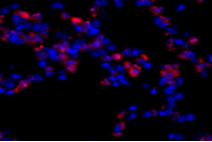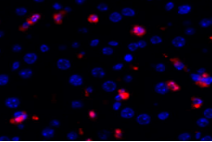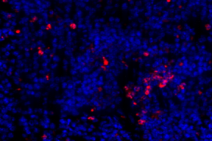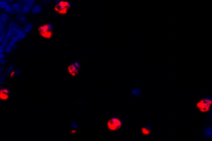| Reactivity: | M |
| Applications: | WB |
| Host Species: | Rabbit |
| Clonality: | Polyclonal |
| Full Name: | CCR7 rabbit polyclonal |
Gene Name: | C-C chemokine receptor type 7 |
Synonyms: | BLR2, CC-CKR-7, CCR-7, CD197, CDw197, CMKBR7, EBI1, C-C motif chemokine receptor 7 |
Immunogen: | KLH conjugated Synthetic peptide corresponding to Mouse CCR7 |
Isotype: | IgG |
Purity: | Affinity purification |
Subcellular location: | |
Uniprot ID: |
Product Usage Information
Applications | Species | Dilution | Positive tissue |
IHC | Human, Mouse | 1: 200-1: 500 | lymphoma, spleen |
IF | Human, Mouse | 1: 200-1: 500 | inflammatory lung, inflammatory liver, inflammatory thymus, spleen |
Background
The protein encoded by this gene is a member of the G protein-coupled receptor family. This receptor was identified as a gene induced by the Epstein-Barr virus (EBV), and is thought to be a mediator of EBV effects on B lymphocytes. This receptor is expressed in various lymphoid tissues and activates B and T lymphocytes. It has been shown to control the migration of memory T cells to inflamed tissues, as well as stimulate dendritic cell maturation. The chemokine (C-C motif) ligand 19 (CCL19/ECL) has been reported to be a specific ligand of this receptor.
Images
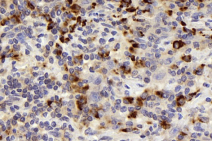 |
Immunohistochemistry analysis of paraffin-embedded human lymphoma using CCR7 (GB11502) at dilution of 1:200. |
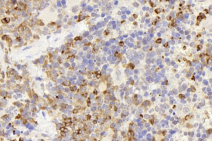 |
Immunohistochemistry analysis of paraffin-embedded mouse spleen using CCR7 (GB11502) at dilution of 1:200. |
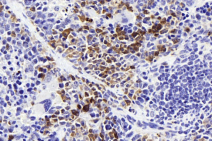 |
Immunohistochemistry analysis of paraffin-embedded mouse spleen using CCR7 (GB11502) at dilution of 1:400. |
|
Immunofluorescent analysis of paraformaldehyde-fixed mouse inflammatory lung using CCR7 (GB11502) at dilution of 1: 500 |
|
Immunofluorescent analysis of paraformaldehyde-fixed mouse inflammatory liver using CCR7 (GB11502) at dilution of 1: 500 |
|
Immunofluorescent analysis of paraformaldehyde-fixed mouse spleen using CCR7 (GB11502) at dilution of 1: 200 |
|
Immunofluorescent analysis of paraformaldehyde-fixed mouse inflammatory thymus using CCR7 (GB11502) at dilution of 1: 200 |
Storage
| Storage | Store at -20°C for one year. Avoid repeated freeze/ thaw cycles. |
| Storage Buffer | PBS with 0.02% sodium azide, 100 μg/ml BSA and 50% glycerol. |

